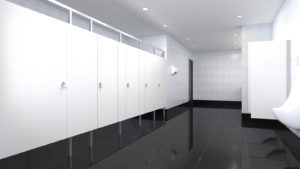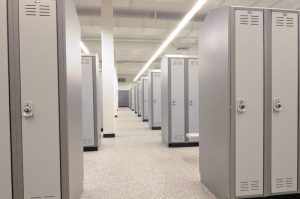Conducting renovations and remodels in your school is important when you need to replace certain materials, fixtures, or components. When it comes to your bathroom, you’ll need to use the right materials to ensure that they’ll be able to last in the sometimes-hostile environment that a school restroom can be due to the moisture and humidity. This is especially true when it involves your toilet partitions.
Here’s a quick guide to choosing the right bathroom partitions for your school.
Choosing a Stronger Material

When it’s time to replace your toilet partitions, you’ll want to make sure that you’re using a strong and durable material that can withstand the elements, as well as rough handling. Phenolic is a commonly used material for toilet partitions because they’re sleek, light, and has a strong screw retention. However, due to the light frame of Phenolic, it can endure some surface damage, so you’ll want a stronger and more reliable material.
Combatting the Restroom Elements
School restrooms are almost always moist, which can have drastic effects on your toilet partitions. Due to the constant humidity, the inner paper-core can become drenched. Over time, this can begin to sprout mold, which can lead to foul odors and lead to respiratory issues. Once mold growth is spotted, the entire partition needs to be replaced. To stay ahead of this, you’ll want to find a material that is solid all the way through and can’t absorb the moisture.
Reducing the Cost of Maintenance
Excessive maintenance on your restroom partitions is never fun. Whether you’ve to tighten the screws, adjust the hardware, or paint over graffiti regularly, you’ll notice that the costs and the man hours go up. Choosing a reliable material that can help you reduce your maintenance costs will not only save you money, but the materials will essentially pay for themselves after a few years.
Keep Privacy in Mind
Privacy is always an important factor when it comes to restrooms. Most toilet partitions leave certain areas exposed through door gaps and open spaces at the tops and bottoms of the stall. These sightlines can effectively be avoided by using more privacy-oriented toilet partitions.
Using HDPE Plastic Partitions
When it’s time to get serious about getting the right partitions for your school, HDPE plastic is always a reliable material to use. This solid plastic provides a more durable structure that can stand up to humidity, moisture, and graffiti. There are plenty of styles and options that can be customized to fit the décor of your school’s restroom. HDPE plastic partitions are guaranteed to last for up to 25 years, which saves you on replacement costs. You can rest easy knowing that you’ll have reliable, durable, cost-effective, and sustainable toilet partitions in your restroom.
When it’s time to consider new toilet partitions, go with an option that will not only exceed your expectations, but one that will last you the years. Want to learn more about HDPE toilet partitions and styles? Check out this FREE eBook, Choosing Bathroom Materials¸ from your friends at Scranton Products.

 Lockers aren’t exactly treated gently. It seems a student’s preferred method of closing their lockers is by slamming them shut. Not only can this damage the door with nicks and dents, but it can also damage the hardware that keeps the door on the frame. Lockers endure a decent amount of wear over the years, so it’s important to routinely check the lockers to be sure that they’re in suitable shape.
Lockers aren’t exactly treated gently. It seems a student’s preferred method of closing their lockers is by slamming them shut. Not only can this damage the door with nicks and dents, but it can also damage the hardware that keeps the door on the frame. Lockers endure a decent amount of wear over the years, so it’s important to routinely check the lockers to be sure that they’re in suitable shape. Usually, the final straw for knowing when it’s time to update your lockers is when your maintenance costs have reached an all-time high. Instead of enduring these costs, as well as the time spent on maintaining your lockers, you should seek out a more cost-effective solution. This can allow you to not only update your lockers, but you can use this time to utilize a better material that can withstand the elements that have worn down your current lockers.
Usually, the final straw for knowing when it’s time to update your lockers is when your maintenance costs have reached an all-time high. Instead of enduring these costs, as well as the time spent on maintaining your lockers, you should seek out a more cost-effective solution. This can allow you to not only update your lockers, but you can use this time to utilize a better material that can withstand the elements that have worn down your current lockers. Creating a Safe Learning Environment
Creating a Safe Learning Environment When you walk down the halls and see instances of vandalism, it’s never fun, especially when there’s graffiti all over the walls and lockers. You can
When you walk down the halls and see instances of vandalism, it’s never fun, especially when there’s graffiti all over the walls and lockers. You can  Taking Preventative Measures
Taking Preventative Measures You’ll be able to spot mold sprouting in the corners of your bathroom, but that’s not the only place it can grow. Often, mold begins to sprout inside
You’ll be able to spot mold sprouting in the corners of your bathroom, but that’s not the only place it can grow. Often, mold begins to sprout inside stalls as their springboard because it’s enclosed and private. However, you can
stalls as their springboard because it’s enclosed and private. However, you can 
 hand sanitizer, there will be a significant drop in student absences. You can put hand sanitizer pumps in bathrooms, the lunch room, and any administrative office. However, you may also want to invest in a hand sanitizer stand in high-traffic areas like major staircases, the library, and anywhere where there are computers. Shared computer keyboards are often a hotbed of germ spread, so be sure to combat it by offering hand sanitizer for students to use after they use the computer.
hand sanitizer, there will be a significant drop in student absences. You can put hand sanitizer pumps in bathrooms, the lunch room, and any administrative office. However, you may also want to invest in a hand sanitizer stand in high-traffic areas like major staircases, the library, and anywhere where there are computers. Shared computer keyboards are often a hotbed of germ spread, so be sure to combat it by offering hand sanitizer for students to use after they use the computer. crowded. In fact, most students contract sicknesses while at school, so you’ll need to take the necessary steps to reduce the spread of disease in your educational facility. However, MRSA (Methicillin-resistant Staphylococcus aureus) has become a common problem in schools. This bacteria can be spread in a variety of ways, but the best way to prevent it from spreading is to stop it at the source: locker rooms and restrooms.
crowded. In fact, most students contract sicknesses while at school, so you’ll need to take the necessary steps to reduce the spread of disease in your educational facility. However, MRSA (Methicillin-resistant Staphylococcus aureus) has become a common problem in schools. This bacteria can be spread in a variety of ways, but the best way to prevent it from spreading is to stop it at the source: locker rooms and restrooms. clean and sanitize the high risk areas
clean and sanitize the high risk areas